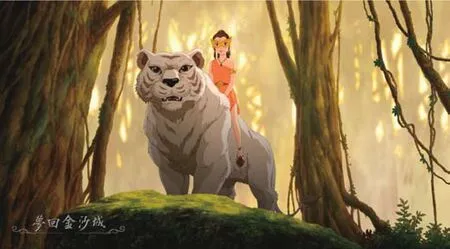Animation Making Waves
2011-11-17ByTANGYUANKAI
By TANG YUANKAI
Animation Making Waves
By TANG YUANKAI
Chinese animation for the first time is close to winning an Academy Award
Although the Chinese animation film The Dreams of Jinsha, one of the 15 films submitted to the Oscar Award Committee for this year’s animation award,wasn’t finally nominated, it has caused a sensation among Chinese audiences. This was the first time Chinese animation has come so close to this prestigious award.
The Dreams of Jinsha, tells a story about the spiritual growth and the dream of a mildly indolent, disrespectful boy named Xiao Long,who travels 3,000 years back in time to the Jinsha Kingdom. Together with the citizens of Jinsha, he guards the kingdom against dark forces and prevents a catastrophe. Because of these experiences Xiao Long becomes responsible and compassionate.
Six years ago, when couple Chen Deming and Su Xiaohong, director and producer of the fi lm respectively, returned to their hometown in southwest China’s Sichuan Province, they visited the Jinsha site museum in Chengdu, Sichuan’s capital city.
The mysterious and delicate historic artifacts at the site immediately reminded the couple of similar scenes inHarry Potterfi lms. They then decided to capture and present Jinsha culture through animation.
“We were moved and excited when we saw those mysterious relics. The idea of making an animated film based on the site struck me at that moment,” Chen said. The idea also won support from the museum,which provided many photos and pictures of the site and related written material.
“An animated film is very influential. I believed the beauty and mysteriousness of the site could be well presented in a fi lm. It will also help to make Jinsha culture more popular,” said Yao Fei, deputy curator of the museum.
From that time on, the couple worked on their creation. “It has taken us fi ve years to fi nish it with several ups and downs. The story has, in all, been revised more than 20 times,” said Su, who also wrote the film’s script. “At the beginning, we consulted many animation producers about the image of a princess thousands of years ago, and they almost all gave the same answer.”
In 2005, when the film was previewed,Chen was not at all satisfied with it, even though his colleagues thought as Chen’s fi rst animation work, it was well done.
At that time, Chen and Su realized making an animated movie was much different from normal film shooting and a fi nished product could be a long distance from the original imagined concept. “It is possible the fi nished product will be totally dissatisfactory. Then you either start all over again or give up. We chose to start again,” said Chen.

A still from The Dreams of Jinsha
A year later, a five-minute sample ofThe Dreams of Jinshawas shown at the Annecy International Animated Festival in France. The festival showing reinforced the con fi dence of the production team. “At fi rst,some foreign colleagues thought we were entrusted by Japan. They did not think the Chinese could make such a work and we thought it was a chance for the world to have another think about Chinese animated fi lm,”Chen said.
“China is not short of the talent necessary to make animation. But many of them copy other things and do not do their own original work. That is why China hasn’t yet produced any masterpieces,” Su said.
“We should learn from world-famous animation masters such as Hayao Miyazaki of Japan. At times, Americans do not do this well with high-end technology but Japanese counterparts can achieve effects by hand painting,” said Su.
“We also need a creative team with an original spirit and to give up the fi xed mindset we are working for Japanese or Western animation companies.”
After being polished over and over again,The Dreams of Jinshafinally reached international B grade, which is recognized by the Oscar Awards Committee.With a 600-strong production team and 280,000 original paintings used up 3 tons of paper, the fi lm cost 80 million yuan ($12 million).
It is being viewed as an “ice-breaking work” for Chinese animation technology. “We have made some technical breakthroughs, and hope that would bring Chinese animation industry some inspiration,” Su said.
In December 2010, when Bill Desowitz,a reporter from Animation World Network,interviewed Chen, he said his 4-year-old daughter loved the fi lm very much, and even cried when she saw touching scenes in the film. Before this, when animation master Aron Warner, the father of theShrekseries,visited China, he expressed his appreciation for the fi lm as well.
The film has also broadcast Jinsha culture widely. A French publisher became very interested in the cultural background after watching the fi lm and has purchased the distribution rights in France.

LAN XINZHEN
